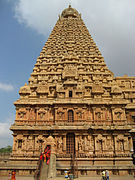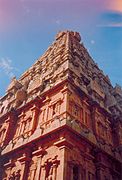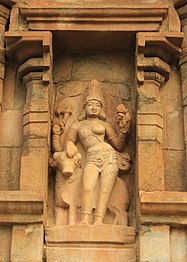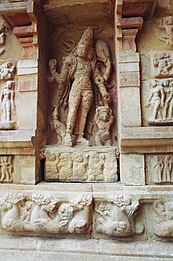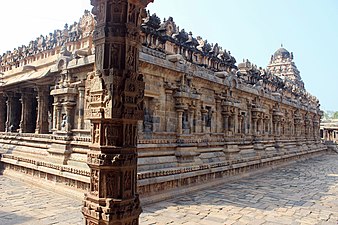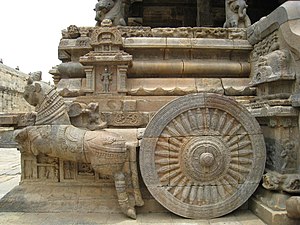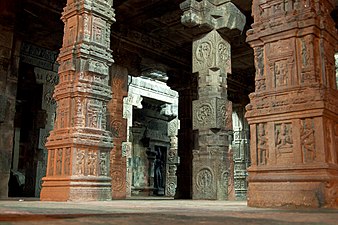Great Living Chola Temples
| UNESCO World Heritage Site | |
|---|---|
 Scenes from the three temples | |
| Location | Tamil Nadu, India |
| Includes | The Brihadisvara Temple Complex, Thanjavur The Brihadisvara Temple Complex, Gangaikondacholapuram The Airavatesvara Temple Complex, Kumbakonam |
| Criteria | Cultural: (ii), (iii) |
| Reference | 250bis |
| Inscription | 1986 (10th Session) |
| Extensions | 2004 |
| Area | 21.88 ha (54.1 acres) |
| Buffer zone | 16.715 ha (41.30 acres) |
| Coordinates | 10°46′59″N 79°07′57″E / 10.78306°N 79.13250°E |
The Great Living Chola Temples is a UNESCO World Heritage Site designation for a group of Chola dynasty era Hindu temples in the Indian state of Tamil Nadu. The temple at Thanjavur was added in the list in 1987, while the other two temples were added in 2004.[1]
Completed between early 11th and the 12th century CE, the monuments include:[2]
- Brihadisvara Temple at Thanjavur, built by Rajaraja I.
- Rajendra Chola I.
- Airavatesvara Temple at Kumbakonam, built by Rajaraja II.
World Heritage Site recognition
The Temple Complex at Thanjavur was recognised in 1987. The Temple Complex at Gangaikonda Cholapuram and the Airavatesvara Temple Complex were added as extensions to the site in 2004. The criteria for inclusion in the "Great Living Chola Temples" site are:
- Criterion (i): The three Cholatemples of Southern India represent an outstanding creative achievement in the architectural conception of the pure form of the Dravidan type of temple.
- Criterion (ii): The Brihadisvara Temple at Thanjavur became the first great example of the Chola temples, followed by a development of which the other two properties also bear witness.
- Criterion (iii): The three Great Chola Temples are an exceptional and the most outstanding testimony to the development of the architecture of the Chola Empire and the Tamil civilizationin Southern India.
- Criterion (iv): The Great Chola temples at Thanjavur, at Gangaikondacholapuram and Kumbakonam are outstanding examples of the architecture and the representation of the Chola ideology.
Temples
Thanjavur is about 340 kilometres (210 mi) southwest of Chennai. Gangaikonda Cholapuram and Darasuram are respectively about 70 kilometres (43 mi) and about 40 kilometres (25 mi) to its northeast.
Brihadisvara Temple in Thanjavur

The
Built out of granite, the
Brihadisvara Temple in Gangaikonda Cholapuram

The
It is dedicated to Shiva and based on a square plan, but the temple reverentially displays Vaishnavism, Shaktism and syncretic equivalence themes of Hinduism with statues of Vishnu, Durga, Surya, Harihara, Ardhanishvara, and others.[12][14][15] In addition to the main shrine with linga, the temple complex has a number of smaller shrines, gopura, and other monuments, with some partially ruined or restored in later centuries. The temple is famed for its bronze sculptures, artwork on its walls, the Nandi and the scale of its curvilinear tower.[12][16][17]
Airavatesvara Temple

The Airavatesvara Temple is in the city of Kumbakonam, South India, completed in 1166 AD.[18] It is one among a cluster of eighteen medieval era large Hindu temples in the Kumbakonam area.[19] The temple is dedicated to Lord Shiva. It also reverentially displays Vaishnavism and Shaktism traditions of Hinduism, along with the legends associated with sixty three Nayanars – the Bhakti movement saints of Shaivism.[20][21][22]
Named after the White Elephant of Indra, this temple is a testimony to the grand temple architecture of the Cholan Empire. It is the last of the three great Cholan temples built by successive generations of kings starting from Rajaraja I. Airavateswara temple was built by Rajaraja II around 1150 AD. One of the striking features of this temple is Rajagambhira Thirumandapam - Royal Courtyard, with intricately carved pillars, long steps made of granite stones and elegant chariots drawn by horse - again hewn out of stone. You will see finer workmanship in this temple than the earlier temples. Darasuram is literally a stone's throw away from Kumbakonam.
The stone temple incorporates a chariot structure, and includes major Vedic and Puranic deities such as Indra, Agni, Varuna, Vayu, Brahma, Surya, Vishnu, Saptamtrikas, Durga, Saraswati, Sri Devi (Lakshmi), Ganga, Yamuna, Subrahmanya, Ganesha, Kama, Rati and others.[23] The temple was much larger and once had seven courtyards according to inscriptions. Only one courtyard survives; parts of the temple such as the gopuram are in ruins, and the main temple and the main temple and associated shrines stand alone.[24] The temple continues to attract large gatherings of Hindu pilgrims every year.[25][23][26]
Kailasnather Temple
The '
The Kailasanathar temple is notable for its intricately carved galaxy of Hindu art in the late 7th- and early 8th-century Tamil tradition. These largely relate to Shaivism, yet also include significant number of themes from Vaishnavism, Shaktism and Vedic deities.[29] The temple is also notable for one of the early and best specimens of Hindu mural art in Tamil Nadu. This is found in the inner walls of the courtyard cells. The murals are in a style that is also found in the Ajanta Caves, as well as in the historic paintings in the 8th-century Vaikunthaperumal temple, also in Kanchipuram.[30] The temple walls have many inscriptions in early scripts, important to the epigraphical study of regional history and Tamil temple traditions.[31]
The structure contains 58 small shrines which are dedicated to various forms of Shiva. These are built into niches on the inner face of the high compound wall of the circumambulatory passage.[32][33] The temple is one of the most prominent tourist attractions of the city.[34]
Gallery
-
View of the Śrī Vimāna of the Thanjavur Temple
-
The granite gopuram (tower) of the Thanjavur Temple
-
Temple at Thanjavur
-
Temple entrance gopurams at Thanjavur
-
An elephant relief on the Thanjavur temple
-
Tamil written on the Thanjavur Temple
-
The pyramidal structure above the sanctum at the Gangaikonda Cholapuram Temple
-
Ardhanarishvara (half Shiva, half Parvati): sculpture at Gangaikonda Cholapuram
-
Stone sculpture at Gangaikonda Cholapuram
-
A pillar in Dravidian architectural-style in Airavatesvara Temple
-
Chariot detail of the Airavatesvara Temple
-
Altar
-
Pillars
References
- ^ "Great Living Chola Temples". World Heritage: Unesco.org. Retrieved 6 November 2010.
- ^ "Great Living Chola Temples" (PDF). UNESCO. Retrieved 6 November 2010.
- ^ Thanjavur, Encyclopaedia Britannica
- ^ a b c "The Archaeological Survey of India (ASI)".
- ISBN 0-00-638784-5.
- ^ S.R. Balasubrahmanyam 1975, pp. 1–21.
- ^ Michell, George (2008). Architecture and art of Southern India. Cambridge University Press. pp. 16–21, 89–91.
- ^ S.R. Balasubrahmanyam 1975, pp. 20–21.
- ^ S.R. Balasubrahmanyam 1975, pp. 1–26.
- ^ Gopal, Madan (1990). K.S. Gautam (ed.). India through the ages. Publication Division, Ministry of Information and Broadcasting, Government of India. p. 185.
- ^ S.R. Balasubrahmanyam 1975, pp. 241–245.
- ^ a b c Great Living Chola Temples, Archaeological Survey of India, Government of India
- ^ Michell 1988, p. 4, 51-53, 145.
- ISBN 81-206-0151-3, pages 291-295
- ^ S.R. Balasubrahmanyam 1975, pp. 241–249.
- ^ S.R. Balasubrahmanyam 1975, pp. 243–249.
- ^ "Great Living Chola Temples". UNESCO World Heritage Centre. 2004.
- ISBN 978-81-321-0981-5.
- ^ Ayyar 1992, pp. 349-350
- ^ S.R. Balasubrahmanyam 1979, pp. 225–245.
- ISBN 978-0-300-06217-5.
- ISBN 978-0-231-51524-5.
- ^ a b S.R. Balasubrahmanyam 1979, pp. 225–234.
- ^ Ayyar 1993, p. 351
- ^ Ayyar 1992, pp. 350-351
- ISBN 978-0-520-28847-8.
- ^ Emma Stein (2017), All Streets Lead to Temples: Mapping Monumental Histories in Kanchipuram, Yale University Press, pp. 23–25, 41–44
- ^ a b K.R. Srinivasan (1972), Temples of South India (Editor: B.V. Keskar), National Book Trust, p. 115–116
- ^ Emma Stein (2017), All Streets Lead to Temples: Mapping Monumental Histories in Kanchipuram, Yale University Press, pp. 47–51
- ^ S Paramasivan (1938), Technique of the Painting Process in the Kailasanatha and Vaikunthaperumal Temples at Kanchipuram, Nature, No. 3599 (October 22), Nature Publishing Group, p. 757
- ISBN 978-0-295-74778-1.
- ^ "Kailasanathar Temple". National Informatics Centre of Government of India. Archived from the original on 30 July 2013. Retrieved 27 July 2013.
- ISBN 978-81-87952-12-1.
- ^ Gopal, Madan (1990). K.S. Gautam (ed.). India through the ages. Publication Division, Ministry of Information and Broadcasting, Government of India. p. 175.
Sources
- Ayyar, P.V. Jagadisa (1993). South Indian Shrines. New Delhi: Asian Educational Services. ISBN 81-206-0151-3.
- Chaitanya, Krishna (1987). Arts of India. Abhinav Publications.
- Davis, Richard (1997). Lives of Indian images. Princeton, N.J: ISBN 0-691-00520-6.
- S.R. Balasubrahmanyam (1979). Later Chola Temples. Thomson Press. OCLC 6921015.
- S.R. Balasubrahmanyam (1975). Middle Chola Temples. Thomson Press. ISBN 978-9060236079.
- Michell, George (1988). The Hindu Temple: An Introduction to Its Meaning and Forms. Chicago: ISBN 0-226-53230-5.
External links
 Media related to Great living Chola temples at Wikimedia Commons
Media related to Great living Chola temples at Wikimedia Commons- UNESCO's World Heritage Site listing the Chola temples





